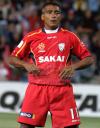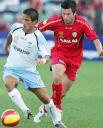Australia’s A-League was born out of the ashes of the old National Soccer League (NSL). The NSL was plagued by poor management, ethnic rivalries and a low profile compared to the ‘traditional’ football codes of rugby league, rugby union and Australian Rules football (depending on which state you lived in). Following a Government inquiry, the old Soccer Australia was wound up and the Football Federation of Australia (FFA) was formed along with the new A-League.
The new administrative setup was designed to usher in an era of professionalism in Australian football. In order to ensure that the A-League was able to attract a high enough profile in the early years, clubs needed a way to attract big name players without blowing out the salary cap. As the Australian market is quite small on a global scale, clubs were never going to attract a household name at the peak of their form. However, hopes were high that a retiring superstar or two might be lured to Australia with the promise of a combination of cash, profile and our awesome climate (just stay out of the sun between 10 and 2). The marquee system was designed to enable clubs to attract well known, skillful and exciting players without threatening the financial viability of clubs and the League.
Squad Rules
It is useful to run through some of the rules governing the makeup of each A-League squad to given an understanding of where the marquee player fits in the picture. Each squad must have:
• a minimum of 20 and maximum of 23 signed players
• at least three U20 players
• no more than four international players
• a total salary cap per team of around AU$1.8 million (expected to reach about $2m by year 5 of the competition)
• additional players can be signed as “injury replacement” players for a minimum of 6 weeks if, at the time of signing, there are less than 15 rostered players available for selection.
Added to that mix is the marquee player. The salary for a marquee player does not count towards the salary cap but is included in the foreign player count. Just to complicate matters further, a loophole in the rules means that injury replacement players also do not count towards the salary cap. Confused yet? Good.
Guest Players — Marquees by Stealth

There have been two guest players in the League, both in Season 2 — Romario and Benito Carbone. Romario played a 4 game stint for Adelaide, scoring a single goal in his final game. While his presence attracted media attention, his football was not extraordinary. It was clear he was just marking time until his 1,000th career goal and it was rumoured at the time that Romario had already promised that one to Vasco de Gama.

Types of Marquee Players
In practice, marquee players can be divided in to two groups: high profile overseas players (for example Dwight Yorke and Juninho) and big name Australian players returning home to give something back to the local game before retirement (for example Ned Zelic, Craig Moore and Tony Vidmar). Generally the overseas players are attacking midfielders or strikers while the local marquees have been selected across the full range of positions including some quality defenders such as Moore and Vidmar.
So there you have it, a quick introduction to the marquee system in the Australian A-League. Tomorrow I will take a look at the contribution of the overseas marquee players to assess what impact, if any, they have had on the A-League.
Part 1: Introduction to the Marquee player system
Part 2: Has the overseas Marquee experiment worked?
Part 3: Coming home – the local Marquee players
Shane Perris is the resident geek of techwhimsy.com and journeyman wingback for Narrabundah FC.
Add Sportslens to your Google News Feed!